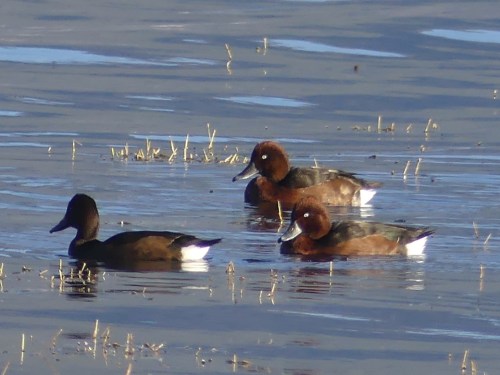After our last session of birding the blinds at Baihualing and lunch, we drove for three hours to Tengchong. The next morning, January 27, we birded Laifengshan National Forest Park. The first birds we saw were two Bar-tailed Treecreepers, which I thought looked an awful lot like my Brown Creepers at home.
Laifengshan is a popular park and visitors that day included several Chinese bird photographers. A young Chinese woman with a camera excitedly showed me a Slender-billed Oriole, one of our targets here. When I had asked Nick about field marks for the oriole, he said that the black mask goes all the way around the nape. Like so often happens, I didn’t realize how beautiful the bird is until I actually saw it.
The park was very pretty and it was a gorgeous sunny day. While walking up to the temple we saw some nice birds including Rufous-bellied and Darjeeling Woodpeckers.
We also saw this Davison’s Leaf Warbler. Asian warblers are rather drab for the most part compared to our colorful North American jewels, however, I was still happy to get identifiable photos of several warbler species during our Yunnan trip.
Shortly after noon, we left Tengchong for the drive to Nabang, where would spend the next 2-1/2 days.
One of my favorite experiences in the Nabang area was time spent at a recently established photo blind/feeding station. We were walking along a forest trail when two young women on a motorcycle came by and said “Come see our blind.” The first half hour seemed to be a total waste of time as we saw absolutely no birds at all. Then, suddenly, birds began to arrive.
I was very, very happy to get wonderful close views of two gorgeous White-crowned Forktails that came in to the feeding area. This Rufous-bellied Niltava was another of my favorites.
Velvet-fronted Nuthatch, Little Pied Flycatcher, and White-tailed Robin were among other species seen well at the blind.
One our way back to the hotel that evening, the Asian Emerald Dove below was in the road in front of the bus. The others could not believe that this was a life bird for me. They seriously thought that I must have seen it before as it seemed a very common Asian bird to them. My bird was special, though, as it had extra white feathers. This species normally has white only on the face and front of the shoulder.
We continued birding in the Nabang area for the next day and a half. On our last morning, we enjoyed this displaying Crested Goshawk, with the distinctive white undertail coverts fluffed up across the rump. In one of those quirks of birding, I have now seen this species three times, but I’m still looking for my life Northern Goshawk at home.
It was then on to Ruili, the last destination of our birding tour. Early on our first morning there, we birded the trail to Moli Waterfalls, part of the Moli Scenic Area, one of the most beautiful locations we visited during the entire trip. One of our main targets was Streaked Wren-Babbler, a sneaky little bird as one would expect with both “wren” and “babbler” in its name. But, due to Nick’s patience and perseverance, I saw the little brown bird.
Nick loves those skulky little brown birds, but I prefer big colorful birds like this Red-headed Trogon. Before this trip, I thought of Trogons as primarily Central American birds, but I learned that they are residents of tropical forests worldwide. The greatest diversity is in the Neotropics, where 24 species occur, but there are also three African species and 12 species of Trogon found in southeast Asia.
February first was the last day of birding for the tour. We started at a ridge-top road just outside of Ruili. I picked up a few more life birds, including Black-crested Bulbul.
But mostly, I just remember a lovely morning with pleasant companions, friendly farmers, and sunshine. I also remember watching drongos that morning, common birds in Yunnan with five different species seen during our two weeks there. I got 104 life birds on the trip, but I would have had more if I hadn’t missed so many birds due to my poor vision. Sometimes, when the others were focused on some distant or skulky bird that I couldn’t find, I just watched drongos, gracefully sallying out for insects and then resettling in the treetops. I was mesmerized by the graceful flights of these birds. I thought that if you could cross a flycatcher with a swallow, you would get a drongo.
And, then the morning was over and we piled back into the bus to start towards the airport. We stopped for lunch on the way at a lovely outside restaurant. While waiting for our food, someone noticed Asian Palm-Swifts flying low over the palm trees at the edge of the parking lot. This seemed like a bonus bird and very appropriate for my last China life bird. After lunch, we drove to the airport for our flight to Kunming. The next morning, the others would start their journeys home and I would fly to Shenzhen where I would visit my son, Dave, and his girlfriend, Rachel.
Parts of the trip were challenging, but I have no regrets. I saw a beautiful part of the world and many gorgeous birds. I enjoyed the company of birders far more accomplished than I will ever be. The other birders and our Zoothera Birding guide, Nick Bray, were fun and wonderfully kind about helping me see as many birds as possible. Near the end when I was getting tired, I thought that it would be my last trip to China, but now I don’t know if I can bear the thought of never again seeing the spectacular beauty of China’s birds.























































